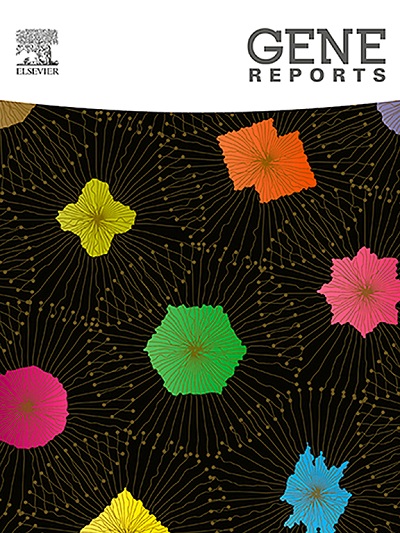Evaluation of the gene expression of CD27 and CD73, and the anti-SARS-CoV-2 Spike IgG level before and after receiving the inactivated SARS-COV-2 vaccine
IF 1
Q4 GENETICS & HEREDITY
引用次数: 0
Abstract
Despite the development of various vaccines against COVID-19, their effectiveness in creating immune memory is still debated by many scientists. Thus, understanding the mechanisms of immune responses against SARS-CoV-2 to increase the effectiveness of vaccination against this virus can be helpful. In this study, we assessed the relationship between the expression levels of the CD27 and CD73 genes with the Anti-SARS-CoV-2 Spike IgG serum level of the peripheral blood mononuclear cells (PBMCs) of 25 male volunteers between the ages of 25 and 55, one, three, and six months after vaccination with an inactivated virus vaccine from Sinopharm. For this purpose, real-time PCR and ELISA tests were used to measure gene expression and evaluate the serum antibody level. Results suggested that with the increase in the expression of the CD27 gene after the first and third month, the anti-SARS-CoV-2 spike IgG serum titer also increases. Interestingly, by reducing the expression of this gene in the sixth month, the antibody titer in these volunteers decreases. In this regard, the results of the examination of CD73 expression show an inverse relationship between the antibody titer against the SARS-CoV-2 virus S protein and the expression of CD73. The results showed a relationship between the expression of genes CD27 and CD73 and the serum level of antibodies in the first, third, and sixth months after vaccination with the first dose of Sinopharm. Of course, this claim should be proven in studies with larger populations.
接种灭活疫苗前后CD27、CD73基因表达及抗SARS-COV-2 Spike IgG水平的测定
尽管针对COVID-19的各种疫苗已经开发出来,但它们在创造免疫记忆方面的有效性仍受到许多科学家的争议。因此,了解针对SARS-CoV-2的免疫反应机制,以提高针对该病毒的疫苗接种的有效性可能会有所帮助。在这项研究中,我们评估了CD27和CD73基因表达水平与25名年龄在25至55岁之间的男性志愿者(接种中国医药集团公司的灭活疫苗后1、3和6个月)外周血单个核细胞(PBMCs)抗sars - cov -2 Spike IgG血清水平的关系。为此,采用实时荧光定量PCR和酶联免疫吸附试验检测基因表达并评价血清抗体水平。结果提示,随着CD27基因表达在1、3个月后的增加,抗sars - cov -2刺突IgG血清滴度也随之升高。有趣的是,通过在第六个月减少这种基因的表达,这些志愿者的抗体滴度降低了。因此,CD73表达检测结果显示,抗SARS-CoV-2病毒S蛋白抗体滴度与CD73表达呈反比关系。结果显示CD27和CD73基因表达与接种第一剂国药后第1、3、6个月血清抗体水平存在相关性。当然,这种说法需要在更大规模的研究中得到证实。
本文章由计算机程序翻译,如有差异,请以英文原文为准。
求助全文
约1分钟内获得全文
求助全文
来源期刊

Gene Reports
Biochemistry, Genetics and Molecular Biology-Genetics
CiteScore
3.30
自引率
7.70%
发文量
246
审稿时长
49 days
期刊介绍:
Gene Reports publishes papers that focus on the regulation, expression, function and evolution of genes in all biological contexts, including all prokaryotic and eukaryotic organisms, as well as viruses. Gene Reports strives to be a very diverse journal and topics in all fields will be considered for publication. Although not limited to the following, some general topics include: DNA Organization, Replication & Evolution -Focus on genomic DNA (chromosomal organization, comparative genomics, DNA replication, DNA repair, mobile DNA, mitochondrial DNA, chloroplast DNA). Expression & Function - Focus on functional RNAs (microRNAs, tRNAs, rRNAs, mRNA splicing, alternative polyadenylation) Regulation - Focus on processes that mediate gene-read out (epigenetics, chromatin, histone code, transcription, translation, protein degradation). Cell Signaling - Focus on mechanisms that control information flow into the nucleus to control gene expression (kinase and phosphatase pathways controlled by extra-cellular ligands, Wnt, Notch, TGFbeta/BMPs, FGFs, IGFs etc.) Profiling of gene expression and genetic variation - Focus on high throughput approaches (e.g., DeepSeq, ChIP-Seq, Affymetrix microarrays, proteomics) that define gene regulatory circuitry, molecular pathways and protein/protein networks. Genetics - Focus on development in model organisms (e.g., mouse, frog, fruit fly, worm), human genetic variation, population genetics, as well as agricultural and veterinary genetics. Molecular Pathology & Regenerative Medicine - Focus on the deregulation of molecular processes in human diseases and mechanisms supporting regeneration of tissues through pluripotent or multipotent stem cells.
 求助内容:
求助内容: 应助结果提醒方式:
应助结果提醒方式:


